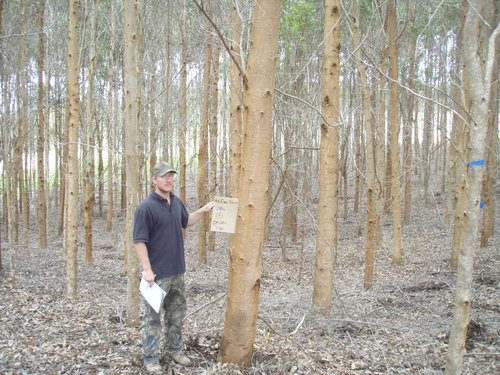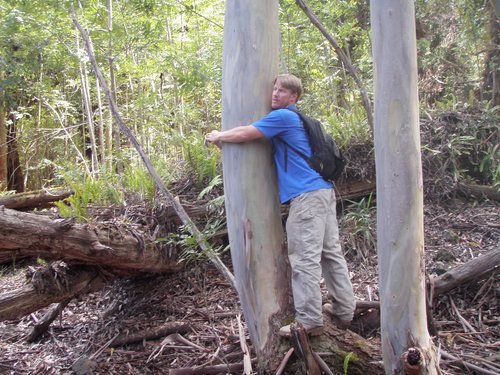In "Partner Perspectives" we get to know the diverse people, roles, and views of wildfire management in the Pacific. Get to know Willie Rice, a forester, GIS professional, and PFX Steering Committee Member. Willie found his way to fire management through GIS, and we’re glad he’s decided to stay involved!
Name: Willie Rice
Role: Forester, Forest Solutions; Pacific Fire Exchange Steering Committee
How would you describe your role?
Willie Rice (WR): At Forest Solutions my title is Forester, which comes with different forest management duties. I have a background in GIS, so I’m also the main go-to guy for any GIS projects or software problems. My daily activities range from managing our operational budgets and writing reports to on-the-ground work like establishment and maintenance. Because Forest Solutions is a relatively small company we need to be able to do all sorts of things, and have a more general role. I get to work at all levels of the organization–I like that.
Can you describe what Forest Solutions does in more detail?
WR: Forest Solutions got started in 1995 specifically as a commercial plantation manager to establish eucalyptus plantations along the Hamakua Coast on Hawai‘i Island. After about 5-10 years of work and on our way toward 13,000 acres of eucalyptus plantation, we started doing some conservation work as well. That’s where I initially got started with Forest Solutions. I was doing things like invasive species control, out-plantings, forest inventory, fire management, in conservation areas above Kona. Now about 70% of the business is conservation work for large private land holders, where we focus on koa forestry. Our longest-running conservation project is a dry-land forestry project above Kawaihae.
“70% of the business is conservation work for large private land holders, where we focus on koa forestry. Our longest-running conservation project is a dryland forestry project above Kawaihae.”
The foresters within our company have a good range of international experience they brought here to Hawai‘i. I have experience in New Zealand while others have experience in South Africa, Indonesia, and Mexico. Commercial forestry in Hawai‘i is small and comprised mostly of eucalyptus, so we’re a very unique company to be able to do both commercial and conservation forestry.
What first got you involved in fire?
WR: In college, I took a few classes in wildfire. It was always interesting to me, but I didn’t think about it too much because I was pretty focused on GIS. When I first moved back to Hawai‘i after college, I had an opportunity through a small grant with Hawai‘i Community Forestry Initiative to do wildfire resource mapping because of my GIS background. People were concerned about fire in the areas of the new eucalyptus plantations along the Hamakua coast. Keep in mind that this was in 2001, when the plantations were new. There were open, ex-sugar lands with lots of people living in the boonies. There weren’t many resources for people to understand what was going on. From the first responder’s perspective, no one knew where these remote houses were located. I worked with the County GIS person to create map of roads, water sources, and homes that first responders could use. I worked a lot with the volunteer firefighters, and also with Hawai‘i Wildfire Management’s (WHWMO) precursor organization--West Hawai‘i Fuels Management Organization. And this was really the beginning of incorporating GIS and GPS into work flows for the county. The person I was working with at the county and I used to joke about being the only ones doing GIS on the island at that time—at least, it felt that way.

At the time there was an opportunity to work for WHWMO too, so I started running some of their volunteer programs and doing GIS for them. After a couple years (2004 I think), the job with Forest Solutions opened up and I couldn’t say no. I still held onto the wildfire side and helped out by staying involved as best as I could. The experience also helped with my new job at Forest Solutions because I needed to do wildfire planning across thousands of acres in Kona. My involvement in wildfire just kind of developed in front of me. I had fun with it and enjoyed the people I was working with.
Share an experience you’ve had in partnering with others for a resource management goal.
WR: When doing the wildfire planning in Kona, we had many questions around how to respond to fires in areas that, at least at the time, had no resources. We looked at water tank placements, for example. Other questions came up around land in Kona that serves as a sanctuary for nēnē geese, which also means there is a relationship to the land with the Division of Forestry and Wildlife (DOFAW). At the time, we didn’t know who to call to get the best fire response. There are private land areas where County has the responsibility of first response, even areas away from town where they don’t have the best resources for it--like four miles or more above a really terrible road in the middle of what feels like nowhere. We realized we needed to work more closely with the island’s fire managers like Big Island Wildfire Coordinating Group (BIGWCG). It includes County Fire and DOFAW, among others. Getting together with them helped us figure out how to better manage private landscapes and get effective help from response agencies who are best qualified to fight the types of fire we envisioned would occur. We learned that the land owner needs to make a clear and direct request through the right channels to Civil Defense, which organizes these things between County and State.
“We realized we needed to work more closely with the island’s fire managers like Big Island Wildfire Coordinating Group . . . County Fire and DOFAW, among others. Getting together with them helped us figure out how to better manage private landscapes and get effective help from response agencies who are best qualified to fight the types of fire we envisioned would occur.”

In 2010, there was a fire in mauka Hōnaunau. Those connections worked well. The National Park responded because they had recently bought the Kahuku section. DOFAW and (I think) PTA also responded. They were all there to assist the County. It was a huge help to have all these different agencies. Needless-to-say, they put the fire out within a few days.
After the Hōnaunau fire, other folks (ranchers) said, “What can we do to meet you guys from County Fire and take you up so you can see our land?” It’s important to have the relationship where folks say, “Hey, we should visit these lands once a year just to familiarize ourselves with areas where we could potentially need to respond.” Showing up to meetings like BIGWCG puts things on others’ radar and then they say, “Okay, how do we solve that problem?”
Do you have any unanswered questions about wildfire?
JBF: Why isn’t there a better and quicker fire restoration response in Hawai‘i? Take the frequent fires on the west side, for example. All these fountain grass lands burn, giving you a nice beautiful open canvas to recreate whatever you can. But three months later the fountain grass is back and no one’s done anything, and the grass-fire cycle just continues. Why is that? Why can’t we get in and do more quick response restoration work even just to spray the fountain grass to keep it from coming back? When there’s no immediate response we miss a good opportunity to do restoration work.
How do you like to spend your free time?
JBF: Right now, I have a three-year-old girl and a four-year-old boy. I’m with them all weekend doing whatever the heck they want to do. We go dangling on the jungle gym, running through the sand, spending as much time as possible with each other doing all sorts of things. They have their own personalities and are changing all the time. I miss out on a lot when I work during the week so weekend is catch-up time. It’s amazing how much changes with them from weekend to weekend.
PFX: What’s something most people don’t know about you?
JBF: I am an Eagle Scout. I was in the Boy Scouts all throughout growing up and got my Eagle Scout when I was 17. My project was to re-paint the school and church where our troop met. My scout master was big on camping so we camped once a month and were one of the caretaker troops for Camp Ehrhorn on Tantalus. I miss that place. I got to go to a national jamboree and a 50-mile backpacking trip at the Philmont Scout Ranch in New Mexico. It was pretty much Boy Scouts and soccer for the first 20 years of my life. Boy Scouts really molded my values and what I like to do nowadays. I hope to pass that on to my kids through scouting.

